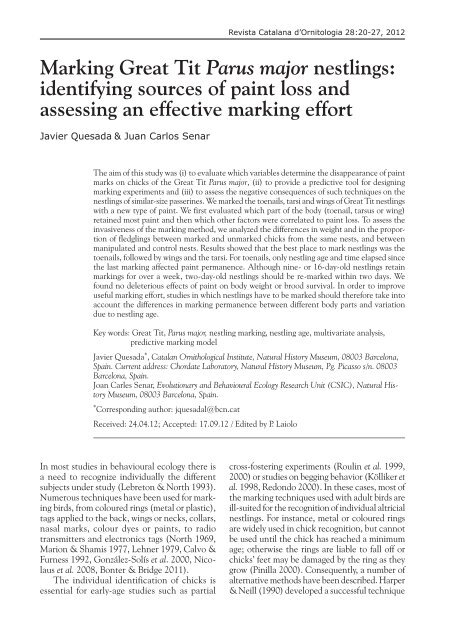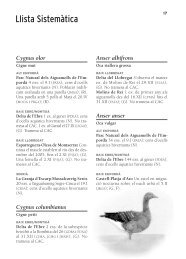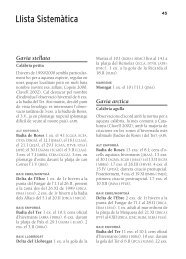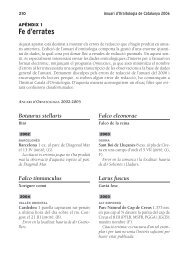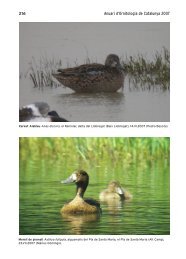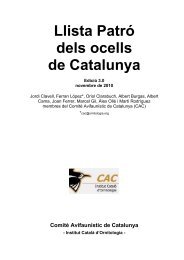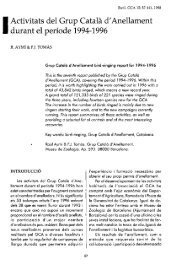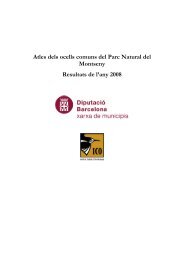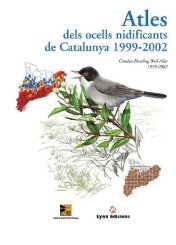Marking Great Tit Parus major nestlings - Institut Català d'Ornitologia
Marking Great Tit Parus major nestlings - Institut Català d'Ornitologia
Marking Great Tit Parus major nestlings - Institut Català d'Ornitologia
Create successful ePaper yourself
Turn your PDF publications into a flip-book with our unique Google optimized e-Paper software.
Revista Catalana d’Ornitologia 28:20-27, 2012<br />
<strong>Marking</strong> <strong>Great</strong> <strong>Tit</strong> <strong>Parus</strong> <strong>major</strong> <strong>nestlings</strong>:<br />
identifying sources of paint loss and<br />
assessing an effective marking effort<br />
Javier Quesada & Juan Carlos Senar<br />
The aim of this study was (i) to evaluate which variables determine the disappearance of paint<br />
marks on chicks of the <strong>Great</strong> <strong>Tit</strong> <strong>Parus</strong> <strong>major</strong>, (ii) to provide a predictive tool for designing<br />
marking experiments and (iii) to assess the negative consequences of such techniques on the<br />
<strong>nestlings</strong> of similar-size passerines. We marked the toenails, tarsi and wings of <strong>Great</strong> <strong>Tit</strong> <strong>nestlings</strong><br />
with a new type of paint. We first evaluated which part of the body (toenail, tarsus or wing)<br />
retained most paint and then which other factors were correlated to paint loss. To assess the<br />
invasiveness of the marking method, we analyzed the differences in weight and in the proportion<br />
of fledglings between marked and unmarked chicks from the same nests, and between<br />
manipulated and control nests. Results showed that the best place to mark <strong>nestlings</strong> was the<br />
toenails, followed by wings and the tarsi. For toenails, only nestling age and time elapsed since<br />
the last marking affected paint permanence. Although nine- or 16-day-old <strong>nestlings</strong> retain<br />
markings for over a week, two-day-old <strong>nestlings</strong> should be re-marked within two days. We<br />
found no deleterious effects of paint on body weight or brood survival. In order to improve<br />
useful marking effort, studies in which <strong>nestlings</strong> have to be marked should therefore take into<br />
account the differences in marking permanence between different body parts and variation<br />
due to nestling age.<br />
Key words: <strong>Great</strong> <strong>Tit</strong>, <strong>Parus</strong> <strong>major</strong>, nestling marking, nestling age, multivariate analysis,<br />
predictive marking model<br />
Javier Quesada * , Catalan Ornithological <strong>Institut</strong>e, Natural History Museum, 08003 Barcelona,<br />
Spain. Current address: Chordate Laboratory, Natural History Museum, Pg. Picasso s/n. 08003<br />
Barcelona, Spain.<br />
Joan Carles Senar, Evolutionary and Behavioural Ecology Research Unit (CSIC), Natural History<br />
Museum, 08003 Barcelona, Spain.<br />
* Corresponding author: jquesadal@bcn.cat<br />
Received: 24.04.12; Accepted: 17.09.12 / Edited by P. Laiolo<br />
In most studies in behavioural ecology there is<br />
a need to recognize individually the different<br />
subjects under study (Lebreton & North 1993).<br />
Numerous techniques have been used for marking<br />
birds, from coloured rings (metal or plastic),<br />
tags applied to the back, wings or necks, collars,<br />
nasal marks, colour dyes or paints, to radio<br />
transmitters and electronics tags (North 1969,<br />
Marion & Shamis 1977, Lehner 1979, Calvo &<br />
Furness 1992, González-Solís et al. 2000, Nicolaus<br />
et al. 2008, Bonter & Bridge 2011).<br />
The individual identification of chicks is<br />
essential for early-age studies such as partial<br />
cross-fostering experiments (Roulin et al. 1999,<br />
2000) or studies on begging behavior (Kölliker et<br />
al. 1998, Redondo 2000). In these cases, most of<br />
the marking techniques used with adult birds are<br />
ill-suited for the recognition of individual altricial<br />
<strong>nestlings</strong>. For instance, metal or coloured rings<br />
are widely used in chick recognition, but cannot<br />
be used until the chick has reached a minimum<br />
age; otherwise the rings are liable to fall off or<br />
chicks’ feet may be damaged by the ring as they<br />
grow (Pinilla 2000). Consequently, a number of<br />
alternative methods have been described. Harper<br />
& Neill (1990) developed a successful technique
Assessing the marking effort in chicks<br />
whereby chicks were ringed with elastic rings.<br />
Velcro leg-tags have also been used for gull<br />
chicks (Willsteed & Fetterolf 1986) and Brewer’s<br />
Blackbirds Euphagus cyanocephalus (Balph 1975).<br />
Fluorescent powder applied to feathers has also<br />
been used in precocial birds (Steketee & Robinson<br />
1995), although this procedure is presumably<br />
not suitable for altricial species.<br />
Some of these methods, however, may be<br />
difficult to apply in very small passerine species<br />
due to the small size of recently hatched chicks.<br />
In these species, one of the most widely applied<br />
techniques is the use of dyes and paints on<br />
different parts of the body including the claws<br />
(Oniki 1981), head (Roulin et al. 1999, 2000,<br />
Buechler et al. 2002) and legs (Balph 1975,<br />
Redondo 2000).<br />
However, individualizing with paint requires<br />
the re-marking of each chick several times<br />
during their development since, otherwise, the<br />
original markings are lost. The loss of marks in<br />
altricial <strong>nestlings</strong> are presumably related to: 1)<br />
environmental conditions such as temperature,<br />
which can alter the properties of the paint; 2)<br />
nestling behaviour in the nest since friction<br />
between chicks could speed up paint loss; 3)<br />
the dermal renovation of the skin. Moreover,<br />
different body parts may lose or retain marks<br />
at different rates due to different amounts of<br />
in-nest chafing and friction. For instance, we<br />
would expect differences in the speed of mark<br />
loss between marks on naked skin (epithelium)<br />
and on nails or feathers (keratin). More exact<br />
knowledge of the most important parameters<br />
causing marks to disappear could save research<br />
time and money, make marking efforts more efficient<br />
and avoid causing <strong>nestlings</strong> unnecessary<br />
stress due to ‘over-visiting’.<br />
Despite the number of published studies on<br />
dyeing or painting techniques in birds, surprisingly<br />
little work has been done to evaluate its efficiency<br />
or the possible deleterious consequences<br />
of marking animals (Calvo & Furness 1992,<br />
Gaunt & Oring 1999, Murray & Fuller 2000).<br />
The aims of this study were (i) to evaluate<br />
which factors determine the disappearance of<br />
the paint applied to the chicks of the <strong>Great</strong> <strong>Tit</strong>,<br />
a small altricial passerine species, (ii) to provide<br />
a predictive tool that will be useful in the design<br />
of marking experiments and (iii) to assess the<br />
possible negative consequences of the use of<br />
such a technique on <strong>nestlings</strong>.<br />
Revista Catalana d’Ornitologia 28 (2012)<br />
Material and methods<br />
The study was carried out during the 2003<br />
breeding season on a population of <strong>Great</strong> <strong>Tit</strong>s<br />
at the field station at Can Catà (Barcelona, NE<br />
Spain) in a forest dominated by oaks and pines<br />
[for more details see Senar et al. (1997)]. The<br />
<strong>Great</strong> <strong>Tit</strong> is an altricial species weighing 17 g<br />
that breeds in cavities but also readily nests in<br />
nest-boxes (Gosler 1993, Cramp 1998). In our<br />
study population females lay 3–11 eggs (authors’<br />
unpublished data).<br />
<strong>Marking</strong> experiment<br />
A total of 171 nest-boxes distributed throughout<br />
the study area were visited every four days in<br />
order to obtain data on the reproductive status<br />
of birds (nest building and laying and hatching<br />
dates). On day 1–3 post-hatching (taken as day<br />
1), half of the chicks of 48 pairs were randomly<br />
marked as soon as possible with red paint (Ecomarker<br />
® , Germany). When there was an odd<br />
number of chicks we always marked the additional<br />
unpaired chick. Eco-marker ® paint is used<br />
in the construction industry; it is particularly<br />
durable in harsh weather conditions, dries very<br />
quickly and is sticky, three reasons that make it<br />
a good candidate for marking birds. Nestlings<br />
(N nests = 48) were marked from day 1–3 on the<br />
toenails of a single foot, on one tarsus and on one<br />
wing (above the carpus). Unlike the head, these<br />
body parts are not (or only very poorly) visible<br />
to parents and so the chance of parents reacting<br />
abnormally to marked chicks was lessened.<br />
We evaluated the permanence of the paint<br />
on the chicks each time nests were revisited<br />
(2–7 days) by establishing an index of mark permanence,<br />
expressed in the form of a qualitative<br />
code: 0= No evidence of mark; 1= Few spots<br />
(remainders) of red paint still visible; 2= Mark<br />
obviously smaller but still clearly visible; 3=<br />
Mark practically intact. Although this index is<br />
qualitative, it does express a continuum of variation<br />
of increasing paint permanence. For this<br />
reason, we considered that we could calculate its<br />
mean value and perform regressions (see below)<br />
as if it were a quantitative variable.<br />
We considered the mean index value of each<br />
brood to avoid any possible pseudoreplication<br />
effect. The same observer (JQ) obtained all<br />
the data. In order to avoid a possible effect of<br />
21
Revista Catalana d’Ornitologia 28 (2012)<br />
observer manipulation, both marked and unmarked<br />
<strong>nestlings</strong> were removed from the nest<br />
each time the broods were marked. Broods were<br />
re-visited and re-marked every 2–7 days during<br />
the nestling phase. We randomly considered only<br />
one ‘re-marking event’ (which implies marking,<br />
re-visiting and evaluation) per nest in order to<br />
maintain the independence of the observations<br />
in the sample.<br />
The evaluation of the deleterious effects<br />
of marking<br />
In order to evaluate any possible deleterious effects<br />
of paint on <strong>nestlings</strong>, we examined chicks<br />
every time that the nests were revisited and<br />
noted any visible anomalies. Furthermore, and<br />
in order to evaluate any possible negative effects<br />
on nestling survival, we analyzed whether or<br />
not there were any differences in the weight (as<br />
a surrogate of body condition) of marked and<br />
unmarked chicks. Birds were weighed with a<br />
pocket balance (Tanita ® , Japan) on day 16 and<br />
the mean weight for each group was used in the<br />
analyses. In addition, we tested whether there<br />
were any differences between the percentage of<br />
marked and unmarked fledglings in the same<br />
nest (% Marked fledged Nestlings = [No. marked<br />
fledged <strong>nestlings</strong>/No. initially marked nestling] x 100, the<br />
same formula being used for non-marked <strong>nestlings</strong>).<br />
We also evaluated an external control by<br />
comparing our sample with 14 broods that were<br />
not manipulated.<br />
Statistical analysis<br />
To evaluate the variables that influence marking<br />
loss we first conducted a Repeated Measures<br />
ANOVA where the dependent variables (levels)<br />
were the values (0–3) of the permanence<br />
of paint on toenails (P nail), tarsi (P tarsus) and<br />
wings (P wing). Combined with a Newman-Keuls<br />
Post-hoc analysis, this ANOVA enabled us to<br />
determine which part of the body retained paint<br />
the most effectively. Afterwards, we focused on<br />
which part of the body retained the greatest<br />
amount of paint cover. We then conducted a<br />
multiple stepwise backward regression whereby<br />
‘the paint permanence of this selected body part’<br />
(the average index of permanence per brood)<br />
was the dependent variable, and the following<br />
variables were the predictors: ‘Hatching date’<br />
22<br />
J. Quesada & J.C. Senar<br />
(1= 1st April), as an indicator of environmental<br />
conditions (given that temperature increases<br />
in the breeding season), ‘Brood size’, as the<br />
number of <strong>nestlings</strong> in the nest when chicks<br />
were marked, ‘Nestling age’ (in days), which<br />
is related to dermal renovation and chick<br />
mobility, and ‘Time of re-marking’, as the time<br />
elapsed since the last marking. We then used a<br />
multiple regression model to explore how paint<br />
retention evolved by studying predicted values<br />
when predictors changed. We were particularly<br />
interested in seeing how the paint was lost at<br />
different nestling ages in relation to the time<br />
elapsed between each visit. We considered three<br />
nestling ages in which chick behaviour (e.g.<br />
mobility) in the nest changes clearly (Redondo<br />
1991) and may have an effect on the rubbing of<br />
body parts. These three ages were 2-, 9- and 16days<br />
old out of a total nestling period of 19–22<br />
days (Cramp 1998).<br />
We used paired-t tests to examine differences<br />
in weight between marked and unmarked fledglings<br />
(at 16-days old), and between manipulated<br />
and control nests. We also evaluated differences<br />
in survival between marked and unmarked <strong>nestlings</strong><br />
by means of a Wilcoxon Matched Pairs<br />
Tests. Mean and standard deviations are given;<br />
we used two-tailed tests with a significance level<br />
of a= 0.05.<br />
Results<br />
Variables affecting paint disappearance<br />
Paint permanence depended on the area of the<br />
body on which the paint was applied and the<br />
best place to mark altricial chicks was found to<br />
be the toenails followed by the wings and tarsi<br />
(Figure 1) (Repeated measures ANOVA F 2,94<br />
= 57.4, P < 0.001; n = 48). A Newman-Keuls<br />
post-hoc analysis showed that all of the body<br />
locations differed significantly from each other<br />
(see Figure 1). Marked nails retained high visibility<br />
on subsequent visits (P nail: mean index ±<br />
SD = 2.26 ± 0.75), while the other body parts<br />
only had the remainders of paint marks or no<br />
signs of the paint at all (P tarsus: mean index ± SD<br />
= 0.98 ± 1.00; P wing: mean index ± SD = 1.26<br />
± 1.10). It is worth noting that an index value<br />
of less than 1 means that at least one chick had<br />
lost its paint marks. Thus, we focused on P nail
Assessing the marking effort in chicks<br />
Paint permanence (Categorized)<br />
3<br />
2<br />
1<br />
0<br />
Nails<br />
P
Revista Catalana d’Ornitologia 28 (2012)<br />
The deleterious effects of paint on chicks<br />
We detected no deleterious effects of paint<br />
on either body condition or chick survival<br />
into the nest. The body mass of marked and<br />
unmarked <strong>nestlings</strong> was similar (Paired t-test:<br />
t 30 = -0.14, P = 0.89; n = 32; mean Marked ±<br />
SD = 15.64 ± 1.55 g; mean Non-marked ± SD<br />
= 15.68 ± 1.63 g); likewise, the mean weight<br />
of chicks from the manipulated nests did not<br />
differ from that of chicks from the untouched<br />
nests (control) (Unpaired t-test: t 45 = -1.35,<br />
P = 0.18; mean Manipulated nests ± SD = 15.62<br />
± 1.42 g n Manipulated nests = 32; mean Control nests<br />
± SD = 15.99± 1.39 g; n Control nests = 14). We<br />
found no differences between the percentage<br />
of marked or unmarked fledglings that left the<br />
nest (Wilcoxon Matched Pairs Test: T=97.50, Z<br />
= 0.28, P = 0.78; n = 31; median Marked fledglings<br />
[25-75% quartiles] = 75.00; [66.00-100.00];<br />
median Non-marked fledglings [25-75% quartiles] =<br />
100.00 [60.00-100.00]. Neither did we find any<br />
differences between the percentage of <strong>nestlings</strong><br />
fledged in manipulated and in control nests<br />
(U- Mann-Whitney: U=289.00; Z = -0,17, P =<br />
0.86; median manipulated nest [25-75% quartiles] =<br />
71.42; [0.00-88.23], n manipulated nests = 47; median<br />
24<br />
J. Quesada & J.C. Senar<br />
Table 1. Multiple regression analysis testing for variation in the paint permanence index on toenails in relation<br />
to hatching date, nesting age, time of remarking and brood size.<br />
Anàlisi de regressió múltiple per testar la variació en l’índex de permanència de la pintura en les ungles dels<br />
peus en relació amb la data d’eclosió, l’edat dels polls, el temps de remarcatge i mida de la llocada.<br />
Multiple backward regression / Regressió multiple pas a pas enrere<br />
Dependent var: Permanence of paint on toenails (P nail) /<br />
Var. dependent: Permanència de la pintura a les ungles dels peus.<br />
r =0.72; r 2 = 0.52; P < 0.0001; n = 48<br />
Initial model / Model inicial<br />
b B B- S.E. t 48 P-level<br />
Intercept / Interceptar 0.98 0.43 2.3 0.02<br />
Hatching date / Data d’eclosió 0.20 0.02 0.01 1.2 0.22<br />
Nestling age / Edat dels poll 0.63 0.09 0.02 3.7
Assessing the marking effort in chicks<br />
<strong>Marking</strong> permanence<br />
(categorized)<br />
3<br />
2<br />
1<br />
0<br />
-1<br />
Nails<br />
Tarsus<br />
Wing<br />
0 4 8 12 16 20 24<br />
Nestling age (in days)<br />
Figure 3. Paint permanence on different parts of<br />
<strong>nestlings</strong>’ bodies in relation to nestling age (in days).<br />
A value of < 1 implies that the marking may have<br />
disappeared in at least one chick.<br />
Permanència de la pintura en diferents parts del cos<br />
dels polls “en relació amb l’edat dels polls (en dies).<br />
Un valor de
Revista Catalana d’Ornitologia 28 (2012)<br />
days when chicks are recently hatched, although<br />
this time period can be extended to a week once<br />
chicks are nine-days old or older. We consider<br />
that this finding could be applied to birds that<br />
are similar in size to the <strong>Great</strong> <strong>Tit</strong>. We encourage<br />
ornithologists to perform similar studies on<br />
other species to establish a standard marking<br />
method and optimize marking effort, thereby<br />
saving time and money and avoiding unnecessary<br />
stress to chicks.<br />
Acknowledgements<br />
We would especially like to thank Cristina Cabrera<br />
for her assistance with the fieldwork and the Gil family<br />
for allowing us to work on their property. Marta<br />
Arenas kindly provided the paint and Lluïsa Arroyo<br />
helped us with the laboratory work. We also wish to<br />
thank two referees and Paola Laiolo for the comments<br />
that improved an earlier version of this manuscript.<br />
Research projects BOS 2003-09589 to JCS and FPI<br />
Grant FP2000-6439 to JQ from the Spanish Research<br />
Council, Ministerio de Ciencia y Tecnología, funded<br />
this work.<br />
Resum<br />
Marcatge de polls de Mallerenga<br />
Carbonera <strong>Parus</strong> <strong>major</strong>: identificació de<br />
les causes de la pèrdua de la pintura i<br />
avaluació de l'esforç efectiu de marcatge<br />
L’objectiu d’aquest estudi és avaluar les variables que<br />
determinen la desaparició del marcatge físic amb<br />
pintura de polls de Mallerenga Carbonera <strong>Parus</strong> <strong>major</strong>,<br />
per proporcionar una eina predictiva de disseny d’experiments<br />
de marcatge i per avaluar les conseqüències<br />
perjudicials d’aquesta tècnica en polls de passeriformes<br />
de mida similar. Es van marcar polls de Mallerenga<br />
Carbonera amb una nova pintura a les ungles, tars i<br />
ala. En primer lloc, vam avaluar quina part del cos<br />
(ungles, tars i ala) conservava millor la pintura i vam<br />
estudiar quins factors es van correlacionar amb la<br />
pèrdua d’aquesta. Per avaluar els efectes deleteris<br />
del marcatge, es van analitzar diferències de pes i de<br />
proporció dels polls marcats i no marcats d'un mateix<br />
niu, i entre nius marcats i no marcats. El millor lloc per<br />
marcar van ser les ungles, seguit per l'ala i el tars. Per<br />
a les ungles, l'edat dels polls i el temps transcorregut<br />
des de l'últim marcatge afecta la permanència de la<br />
marca. Per evitar la pèrdua del marcatge, els polls de<br />
dos dies d’edat s’haurien de marcar abans de dos dies<br />
entre cada remarcatge, mentre que els polls de més<br />
edat (9 a 16 dies) poden mantenir la marca durant més<br />
d’una setmana. No es va trobar cap efecte deleteri de<br />
26<br />
J. Quesada & J.C. Senar<br />
la pintura en el pes corporal o la supervivència dels<br />
polls. Els estudis en els quals s’han de marcar els polls,<br />
haurien de tenir en compte les diferències en la permanència<br />
de la marca entre les diferents parts del cos<br />
i l’edat dels polls per fer un millor esforç de marcatge.<br />
Resumen<br />
Marcaje de pollos de Carbonero Común<br />
<strong>Parus</strong> <strong>major</strong>: identificación de las causas<br />
de la pérdida de la pintura y evaluación<br />
del esfuerzo efectivo de marcaje<br />
El objetivo de este estudio es evaluar las variables<br />
que determinan la desaparición del marcaje físico<br />
con pintura de pollos de Carbonero Común <strong>Parus</strong><br />
<strong>major</strong>, para proporcionar una herramienta predictiva<br />
de diseño de experimentos de marcaje y para evaluar<br />
las consecuencias perjudiciales de esta técnica en<br />
pollos de paseriformes de tamaño similar. Se marcaron<br />
pollos de Carbonero Común en las uñas, tarso y ala<br />
con una nueva pintura. En primer lugar, evaluamos<br />
qué parte del cuerpo (uñas, tarso y ala) conservaba en<br />
mayor grado la pintura y estudiamos qué factores se<br />
correlacionaron con la pérdida de ésta. Para evaluar el<br />
perjuicio del marcaje, se analizaron diferencias de peso<br />
y de proporción de pollos marcados y no marcados de<br />
un mismo nido, y entre nidos marcados y no marcados.<br />
El mejor lugar para marcar fueron las uñas, seguido<br />
por el ala y el tarso. Para las uñas, y para evitar la<br />
pérdida del marcaje, los pollos de dos días de edad se<br />
deberían marcar antes de dos dias, mientras que pollos<br />
de mayor edad (9 a 16 días) pueden mantener la marca<br />
durante más de una semana. No se encontró ningún<br />
efecto deletéreo de la pintura en el peso corporal o la<br />
supervivencia de los pollos. Los estudios en los que<br />
se deben marcar pollos, deberían tener en cuenta las<br />
diferencias en la permanencia de la marca entre las<br />
diferentes partes del cuerpo y la edad de los pollos<br />
para realizar un mejor esfuerzo de marcaje.<br />
References<br />
Balph, M.H. 1975. Development of young Brewer's<br />
blackbirds. Wilson Bull. 87: 207–230.<br />
Bonter, D.N. & Bridge, E.S. 2011. Applications of<br />
radio frequency identification (RFID) in ornithological<br />
research: a review. J. Field Ornithol. 82: 1–10.<br />
Buechler, K., Fitze, P.S., Gottstein, B. & Richner,<br />
H. 2002. Parasite-induced maternal response<br />
in a natural bird population. J. Anim. Ecol. 71:<br />
247–252.<br />
Calvo, B. & Furness, R.W. 1992. A review of the<br />
use and the effects of marks and devices on birds.<br />
Ring. Migr. 13: 129–251.<br />
Cramp, S. 1998. The Complete Birds of the Western<br />
Palearctic on CD-Rom. Oxford: Oxford University<br />
Press.
Assessing the marking effort in chicks<br />
Frankel, A.I. & Baskett, T.S. 1963. Color marking<br />
disrupts pair bonds of captive mourning doves. J.<br />
Wild. Manag. 27: 124–127.<br />
Galvan, I., Amo, L. & Sanz, J. J. 2008. Ultravioletblue<br />
reflectance of some nestling plumage patches<br />
mediates parental favouritism in great tits <strong>Parus</strong><br />
<strong>major</strong>. J. Avian Biol. 39: 277–282.<br />
Gaunt, A. S. & Oring, L. W. 1999. Guidelines to the<br />
use of wild birds in research. 2nd. ed. Washington:<br />
The Ornithological Council.<br />
González-Solís, J., Becker, P.H. & Wendeln, H.<br />
2000. El marcaje individual de poblaciones salvajes<br />
de vertebrados mediante transponders:<br />
resultados en una colonia de Charrán Común.<br />
Etologuía 18: 3–26.<br />
Gosler, A. G. 1993. The <strong>Great</strong> <strong>Tit</strong>. London: Hamlyn.<br />
Griggio, M., Morosinotto, C. & Pilastro, A. 2009.<br />
Nestlings’ carotenoid feather ornament affects<br />
parental allocation strategy and reduces maternal<br />
survival. J. Evol. Biol. 22: 77–2085.<br />
Harper, R.G. & Neill, A.J. 1990. Banding techniques<br />
for small <strong>nestlings</strong> passerines. J. Field Ornithol.<br />
61: 212–213.<br />
Kölliker, M., Richner, H., Werner, I. & Heeb, P.<br />
1998. Begging signals and biparental care: nestling<br />
choice between parental feeding locations. Anim.<br />
Behav. 255: 215–222.<br />
Lebreton, J.D. & North, P. M. 1993. Marked individuals<br />
in the study of bird population.Basel:<br />
Birkhaüser Verlag.<br />
Lehner, P.N. 1979. Handbook of ethological methods.<br />
New York: Garland STPM Press.<br />
Marion, W.R. & Shamis, J.D. 1977. An annotated<br />
bibliography of bird marking techniques. Bird<br />
Banding 48: 42–61.<br />
Murray, D.L. & Fuller, M.R. 2000. A critical review<br />
of the effects of marking on the biology of vertebrates.<br />
In Boitani, L. & Fuller, T.K.(eds.). Research<br />
Revista Catalana d’Ornitologia 28 (2012)<br />
techniques in animal ecology. Controversies and<br />
consequences. Pp. 15–64. New York: Columbia<br />
University Press.<br />
Nicolaus, M., Bouwman, K.M. & Dingemanse,<br />
N.J. 2008. Effect of PIT tags on the survival and<br />
recruitment of <strong>Great</strong> <strong>Tit</strong>s <strong>Parus</strong> <strong>major</strong>. Ardea 96:<br />
286–292.<br />
North, C.A. 1969. <strong>Marking</strong> methods for House Sparrows.<br />
The Ring 60: 238–242.<br />
Oniki, Y. 1981. Individual recognition of <strong>nestlings</strong>. J.<br />
Field Ornithol. 52: 147–148.<br />
Parejo, D., Avilés, J.M. & Rodríguez, J. 2010. Visual<br />
cues and parental favouritism in a nocturnal bird.<br />
Biol. Lett. 6: 171–173.<br />
Pinilla, J. (coord.). 2000. Manual para el anillamiento<br />
científico de aves. Madrid.: SEO/BirdLife y<br />
DGCN-MIMAM.<br />
Redondo, A.J. 2000. Breeding biology of the Azurewinged<br />
Magpie Cyanopica cyanus. Parental-filial<br />
relationships. Cordoba: University of Cordoba,<br />
Spain. Ph.D Thesis.<br />
Redondo, T. 1991. Early stages of vocal ontogeny in<br />
the magpie (Pica pica). J. Ornithol. 132: 145–163.<br />
Roulin, A., Ducrest, A. L. & Dijkstra, C. 1999. Effect<br />
of brood size manipulations on parent and offspring<br />
in the barn owl Tyto alba. Ardea 87: 92–100.<br />
Roulin, A., Jungi, T.W., Pfister, H. & Dijkstra, C.<br />
2000. Female barn owls Tyto alba advertise good<br />
genes. Proc. R. Soc. Sci. (B). 267: 937–941.<br />
Senar, J.C., Domènech, J., Carrascal, L.M. &<br />
Moreno, E. 1997 A funnel trap for the capture of<br />
tits. Butll. Grup <strong>Català</strong> d’Anellament 14: 17–24.<br />
Steketee, A.K. & Robinson, A. 1995. Use of fluorescent<br />
powder for tracking American Woodcock<br />
broods. Auk 112: 1043–1045.<br />
Willsteed, P.M. & Fetterolf, P.M. 1986. A new technique<br />
for individually marking gull chicks. J. Field<br />
Ornithol. 57: 310–313.<br />
27


